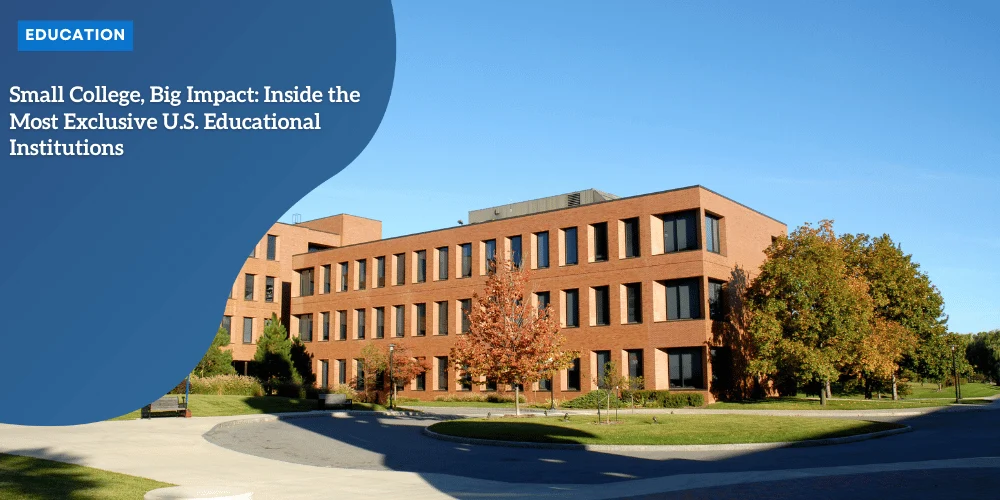Small College, Big Impact: Inside the Most Exclusive U.S. Educational Institutions

Anúncios
Understanding Small Colleges: A Unique Educational Landscape
Definition and Scope of Small Colleges with Enrollments Under 900 Students
Small colleges, often defined by their enrollments of under 900 students, provide a remarkable alternative to larger universities.
These institutions range in size from intimate environments of just over 100 students to nearly 900 students.
They offer unique academic experiences, where students can enjoy close-knit communities and personalized educational opportunities.
Balance Between Intimate Learning Environments and Limited Resources
One of the most striking aspects of small colleges is the balance between their intimate learning environments and the limitations imposed by their size.
Anúncios
Small colleges excel in creating personalized learning atmospheres where students can build strong relationships with faculty and peers.
However, this intimacy sometimes comes at the cost of limited academic programs and extracurricular activities compared to their larger counterparts.
Despite these challenges, small colleges often excel in specific, niche academic areas, providing robust, focused education.

Importance of Student-Faculty Ratios and Personalized Attention
A significant advantage of small colleges is their low student-faculty ratios, which enable greater personalized attention for each student.
Anúncios
For example, Webb Institute offers a 9:1 student-faculty ratio, facilitating intensive, individualized mentorship and support.
This kind of environment allows for tailored academic guidance, mentoring, and vast opportunities for students to engage deeply with their studies and develop meaningful relationships with their professors.
The high levels of student-faculty interaction contribute to impressive graduate outcomes, with many of these institutions boasting high job placement rates and successful alumni networks.
Navigating the landscape of small colleges illuminates their distinct benefits and challenges, laying a foundation for understanding their unique contributions to higher education.
As we delve deeper, the focus will shift to how these institutions foster specialized academic programs and innovative learning that set them apart within the educational sphere.
Specialized Academic Programs and Innovative Learning
Webb Institute’s Naval Architecture Program
Webb Institute in New York is a beacon of specialized education, noted for its singular focus on naval architecture and marine engineering.
With a total enrollment of just over 100 students and a 9:1 student-faculty ratio, Webb offers deeply personalized and intensive learning experiences.
The school’s unique academic structure culminates in a dual bachelor of science degree.
Each year, students engage in a mandatory eight-week internship over the winter term, earning practical experience anywhere in the U.S. or abroad.
This immersion in real-world applications ensures that Webb Institute boasts a 100% job placement rate upon graduation, a testament to its specialized and focused curriculum.
College of the Atlantic’s Human Ecology Curriculum
Nestled on an island in Acadia National Park, College of the Atlantic (COA) in Maine adopts a pioneering approach to education.
Eschewing traditional majors, COA allows its approximately 350 students to craft personalized study paths, all centered around the core concept of human ecology.
This innovative curriculum encourages interdisciplinary learning and critical thinking.
The college’s setting provides a natural laboratory with gardens, an arboretum, and a sustainable campus that was the first to achieve carbon neutrality.
COA’s emphasis on environmental stewardship and hands-on learning creates an immersive educational experience that is both comprehensive and highly customized.
Innovative and Customized Study Paths
At institutions like Webb Institute and College of the Atlantic, the emphasis on specialized education and innovative learning paths is evident.
Other small colleges also offer unique academic programs that allow students to design their educational journeys.
For instance, Sweet Briar College in Virginia provides students with opportunities to engage in practical experiences like equestrian activities and beekeeping, integrating hands-on learning with traditional studies.
These specialized academic programs not only cater to niche interests but also prepare students for specific career paths by blending rigorous academics with practical, real-world experiences.
This approach helps students develop a deep expertise in their chosen fields, fostering both personal and professional growth.
As we move forward, we’ll explore how the integration of academic life with residential experiences creates tight-knit communities that enrich the overall college experience.
Campus Life and Community Engagement
Integration of Residential Life with Academic Experience
Small colleges excel in linking residential life with academic pursuits, fostering close-knit communities.
At Webb Institute, all undergraduates live on-campus, creating a unique bond among students immersed in a rigorous naval architecture and marine engineering program.
The College of the Atlantic enhances this connection by hosting Sunday group meals in residence halls, which offers informal opportunities for academic discussions and community building.
Distinctive Traditions and Community-Building Activities
Traditions play a significant role in molding the culture of small colleges, establishing a sense of belonging and heritage.
For instance, Whittier College celebrates the “Light of Learning” ceremony, where students pass around candles to signify the sharing of knowledge.
At Sweet Briar College, students enjoy the natural landscape through hands-on activities such as growing vegetables, beekeeping, and equestrian events.
These unique traditions contribute to a cohesive and engaged student body.
Student Involvement in Campus Decision-Making and Activities
Given their small size, these colleges often provide students with substantial influence in campus decision-making.
Student government bodies at small colleges frequently work closely with faculty and administration to shape institutional policies and activities.
This participatory approach fosters leadership skills and ensures that student voices are integral to the governance and operational aspects of the college experience.
These practices underscore the profound impact of a dynamic campus life on the overall student experience, demonstrating the strength of community in small college settings.
Environmental Connection and Sustainability
Campus Locations Offering Unique Natural Environments
Small colleges often find themselves nestled in breathtaking locales, providing students with unparalleled access to natural surroundings.
For instance, the College of the Atlantic is situated on an island within Acadia National Park in Maine.
This idyllic setting allows students to interact closely with the natural world, accentuating their study of human ecology.
In Virginia, Sweet Briar College lies in the foothills of the Blue Ridge Mountains, enabling a myriad of outdoor activities such as hiking and horseback riding.
These picturesque settings not only offer stunning backdrops but also enrich the educational experience.
Integration of Environmental Studies and Outdoor Activities
Integrating environmental studies with hands-on, outdoor activities is a hallmark of these small colleges.
At the College of the Atlantic, the curriculum is inherently designed to include outdoor experiential learning.
Students engage in activities like marine research and live sustainably right on campus.
Sweet Briar College encourages students to participate in laboratories where they grow their own vegetables and practice beekeeping.
Similarly, Lyon College offers opportunities for camping, fishing, and rock climbing in the nearby Ozark Mountains.
These experiences equip students with practical skills and an environmental consciousness.
Sustainability Initiatives and Green Campus Practices
Sustainability is more than a buzzword at these institutions; it is a lived practice.
The College of the Atlantic was the first to achieve carbon neutrality in 2007.
This commitment is evident across their green campus, which includes arboretums and organic gardens.
Meanwhile, Sweet Briar College emphasizes sustainable agriculture and eco-friendly campus operations.
Efforts include reducing waste and promoting renewable energy sources.
At Lyon College, students and faculty are continuously engaged in sustainability initiatives, from maintaining trails to advocating for responsible environmental practices.
These efforts at small colleges ensure a balanced life between academia and environmental stewardship.
By nurturing a profound connection with nature, they cultivate environmentally responsible scholars and citizens.
The focus on practical skills not only enriches student learning but also exudes a sense of community and shared responsibility.
Career Preparation and Student Success
Small colleges excel in preparing students for successful careers by offering unique opportunities for practical experiences and individualized guidance, which are often missing in larger institutions.
Internship Programs and Practical Experience Opportunities
One of the standout features of small colleges is their robust internship programs.
For example, all students at Webb Institute must complete eight-week internships each year, anywhere in the U.S. or abroad.
This requirement ensures that Webb graduates leave with significant real-world experience, contributing to their impressive 100% job placement rate upon graduation.
Similarly, College of the Atlantic integrates hands-on learning through various campus facilities such as organic gardens, an arboretum, and a farm.
This on-the-ground training aligns with their commitment to human ecology, providing students with practical skills that are directly applicable to their fields of study.
Mentorship and Individualized Career Guidance
Personalized mentoring is another cornerstone of small college education.
With low student-to-faculty ratios, such as the 9:1 at Webb Institute, students receive tailored academic and career advice.
Colleges like Pfeiffer University enhance this experience with structured mentorship programs that pair students with both peer and faculty mentors.
This approach fosters a supportive environment where students can receive in-depth guidance on research projects and career paths.
Graduate Outcomes and Professional Preparation Advantages
The tangible results of these efforts are evident in the graduate outcomes.
Small colleges often boast high job placement rates and successful alumni.
The focused study programs and internships ensure that students are well-prepared for professional life.
By the time they graduate, students have already built strong connections in their industries, making the transition into their careers more seamless.
The emphasis on small class sizes, extensive mentorship, and practical experiences not only equips students with the necessary skills but also imbues them with confidence and a network of supportive relationships that prove invaluable in their professional journeys.
As we continue to explore the distinctive features of small colleges, it’s essential to consider their environmental connection and sustainability efforts, which further enrich the educational landscape.
Challenges and Considerations
Limited Range of Academic Programs and Extracurricular Activities
Small colleges, while offering personalized education, often come with a limited range of academic programs and extracurricular activities.
Unlike larger institutions that boast a multitude of majors, minors, and clubs, smaller colleges may focus on niche programs to maintain their unique identity.
For instance, Webb Institute, with its specialized degree in naval architecture and marine engineering, and the College of the Atlantic, which revolves around human ecology, exemplify limited but deeply immersive curricula.
Such focused educational paths can be both a blessing and a challenge, depending on a student’s academic aspirations and interests.
Financial Sustainability and Institutional Stability
Ensuring financial stability is another significant consideration for small colleges.
With fewer students contributing to tuition revenues, these institutions often face tighter budgets.
This financial pressure can impact everything from campus facilities to the breadth of services offered. Sweet Briar College, which narrowly avoided closure in 2015, serves as a poignant reminder of the financial vulnerabilities small colleges can face.
To combat this, many institutions engage in active fundraising, seek grants, and emphasize strong alumni relations to bolster their financial standing.
Balancing Intimacy with Educational Breadth
A key strength of small colleges is their intimate learning environments, characterized by low student-faculty ratios and close-knit communities.
However, this intimacy can also pose a challenge when balancing educational breadth.
While personalized attention and mentorship are highly beneficial, the limited number of faculty may restrict the variety of courses available, potentially affecting students whose interests lie outside the college’s primary focus areas.
Therefore, small colleges often strive to innovate within these constraints, offering interdisciplinary studies and opportunities for students to design their own academic paths.
Despite these challenges, small colleges offer unique, enriching experiences that larger institutions might struggle to replicate.
Their commitment to education, community, and sustainable practices continues to attract students who value a personalized, impactful college journey.






